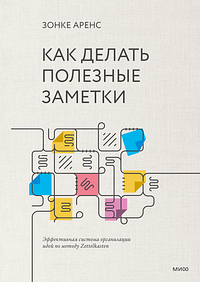Take a photo of a barcode or cover
582 reviews for:
Как делать полезные заметки. Эффективная система организации идей по методу Zettelkasten
Зонке Аренс, Sönke Ahrens, Sönke Ahrens
582 reviews for:
Как делать полезные заметки. Эффективная система организации идей по методу Zettelkasten
Зонке Аренс, Sönke Ahrens, Sönke Ahrens
A motivating read for any self-directed learner seeking a sustainable system for their reading, learning, and research.
Ahrens argues that a Zettelkasten (as famously employed by prolific sociologist Niklas Luhmann) is just the external scaffolding we need to 1) Free up working memory space in our brains which can be better utilized for seeking patterns and making connections, and 2) Have a body of knowledge, tailored to our own perspectives and oriented towards our own research projects, that will be able to grow with us over the years.
When you lodge new information into this existing network of knowledge (that is, your Zettelkasten, second brain, slip-box, whichever you choose to call it) you facilitate its deeper understanding and increase its chances of it being integrated into your long-term memory.
The book does get a little redundant, especially towards the end, and I admit I was getting a little short with it. But it feels like a timely and essential read, especially for someone like me who struggles with organizing my self-guided studies.
Ahrens argues that a Zettelkasten (as famously employed by prolific sociologist Niklas Luhmann) is just the external scaffolding we need to 1) Free up working memory space in our brains which can be better utilized for seeking patterns and making connections, and 2) Have a body of knowledge, tailored to our own perspectives and oriented towards our own research projects, that will be able to grow with us over the years.
When you lodge new information into this existing network of knowledge (that is, your Zettelkasten, second brain, slip-box, whichever you choose to call it) you facilitate its deeper understanding and increase its chances of it being integrated into your long-term memory.
The book does get a little redundant, especially towards the end, and I admit I was getting a little short with it. But it feels like a timely and essential read, especially for someone like me who struggles with organizing my self-guided studies.
informative
medium-paced
Although I did not implement his whole system (I tried it for a bit, but it was way too much work) this book did wonders to my writers block by teaching me to write as I research, rather than waiting until the end.
informative
slow-paced
interesting idea and practical tips with useful context.
feels padded and extended to its absolute limit at 177 pages.
could have been 60 pages long easily
feels padded and extended to its absolute limit at 177 pages.
could have been 60 pages long easily
informative
medium-paced
At first the book seemed shallow and repetetive; however, I started to put into practice the techniques I was reading about and couldn't be more impressed by how effective they are.
informative
fast-paced
Mostly an overview of the zettlekasten system with a lot of fluff (context), but the context is helpful and interesting.
I wish I had read this as an undergraduate. It breaks apart why the method of note-taking seen in schools is terrible and only reinforces the departmentalized structure that philosophy of education seeks to recapitulate into its students. Basically: take literature notes while reading, translating what you read into your own words. Then take permanent notes on those notes, abstracting out those ideas from their context in the work while trying to connect one atomic idea with another. This network of notes becomes the building blocks of a career as a scholar, researcher, or writer, or whatever. He sells this process over and over and over. It feels repetitive, but that is the point. It references some hokey pop-sci books where I wish it would reference more articles, though there’s plenty of that. (Though
I haven’t heard of many of the folks he references; there’s a thread of German social science that didn’t make it to my learning sciences education, though there’s a lot of overlap of ideas.) Reading up more about [the author], he uses [Roam Research] now, which I also use, and which makes sense. But the tools you use matter so much less than that cycle of taking literature notes in your own words, idea by idea, then writing notes about those notes, isolating atomic ideas (usually in the form of claims or statements), then connecting those atomic ideas to others. It’s that easy, that simple. But it takes practice. You’ll start to do what the book says with the book itself, and it seems specifically built for this. Even if you don’t have a totalizing system, if this book gets you to stop highlighting and underlining (though that’s fine, but not enough) and write down full sentences translating what you’re reading into your own words, you’ll be in a much better place than when you started, at the beginnings of a virtuous and productive cycle. He leans on the network effects of this method, the dynamics of it. I can imagine this book will infuriate some people, but that’s fine.
I haven’t heard of many of the folks he references; there’s a thread of German social science that didn’t make it to my learning sciences education, though there’s a lot of overlap of ideas.) Reading up more about [the author], he uses [Roam Research] now, which I also use, and which makes sense. But the tools you use matter so much less than that cycle of taking literature notes in your own words, idea by idea, then writing notes about those notes, isolating atomic ideas (usually in the form of claims or statements), then connecting those atomic ideas to others. It’s that easy, that simple. But it takes practice. You’ll start to do what the book says with the book itself, and it seems specifically built for this. Even if you don’t have a totalizing system, if this book gets you to stop highlighting and underlining (though that’s fine, but not enough) and write down full sentences translating what you’re reading into your own words, you’ll be in a much better place than when you started, at the beginnings of a virtuous and productive cycle. He leans on the network effects of this method, the dynamics of it. I can imagine this book will infuriate some people, but that’s fine.
Effective and critical
This book was very effective, insightful, and opened my mind to how I can improve not only my note-taking habits, but also my critical thinking.
This book was very effective, insightful, and opened my mind to how I can improve not only my note-taking habits, but also my critical thinking.
The book is based on Niklas Luhmann's "Zettelkasten" (slip-box) system and explores why Luhmann was so productive with it. While doing this it provides directions how to take smart notes and explains what to do with them.
The author has connected many dots when it comes to learning, thinking, remembering, planning and creative writing. Personally the book was of tremendous value to me and closed some important gaps in my understanding. I have tried to build my own Knowledgebase with different tools in the past (one based on MediaWiki, which worked quite well, today I am using "Joplin").
What I have missed until now: too much hierarchy is bad. You need the notes in a flat structure to allow for serendipity, to stumble accidentally upon them in different contexts. An "index" card would be nothing more than a simple note so that no hierarchy is forced upon you. Links are important and need to be created actively. By doing this you work with your notes and deepen connections.
But the most important one: use the slip-box as a media (!) to think. It can't be done just in your head while references and notes are looked up. No, the conclusions and new ideas need to be written down as notes in a clear language. They are open for further elaboration or challenges and it will also become clear immediately if something has been REALLY understood - or if you only "think" you do.
I would encourage students to read about the Zettlkasten method and to try it out. I am afraid the whole concept might be too sophisticated in its simplicity so at the end of the day people will probably end up with a structure that is too rigid and with notes that have been copied 1:1. Don't fool yourself, collecting information is not the same and if there is just one takeaway then remember this: create concise notes in your own words.
The author has connected many dots when it comes to learning, thinking, remembering, planning and creative writing. Personally the book was of tremendous value to me and closed some important gaps in my understanding. I have tried to build my own Knowledgebase with different tools in the past (one based on MediaWiki, which worked quite well, today I am using "Joplin").
What I have missed until now: too much hierarchy is bad. You need the notes in a flat structure to allow for serendipity, to stumble accidentally upon them in different contexts. An "index" card would be nothing more than a simple note so that no hierarchy is forced upon you. Links are important and need to be created actively. By doing this you work with your notes and deepen connections.
But the most important one: use the slip-box as a media (!) to think. It can't be done just in your head while references and notes are looked up. No, the conclusions and new ideas need to be written down as notes in a clear language. They are open for further elaboration or challenges and it will also become clear immediately if something has been REALLY understood - or if you only "think" you do.
I would encourage students to read about the Zettlkasten method and to try it out. I am afraid the whole concept might be too sophisticated in its simplicity so at the end of the day people will probably end up with a structure that is too rigid and with notes that have been copied 1:1. Don't fool yourself, collecting information is not the same and if there is just one takeaway then remember this: create concise notes in your own words.







